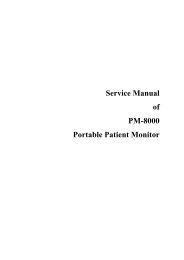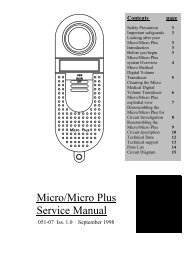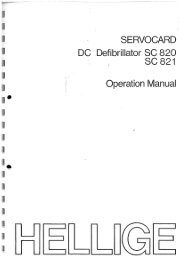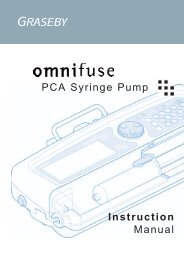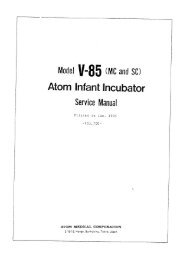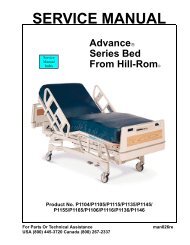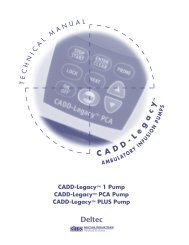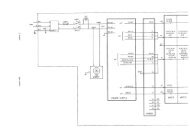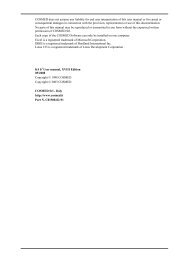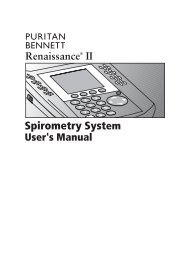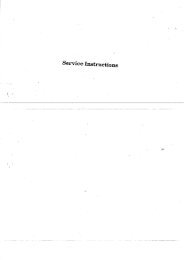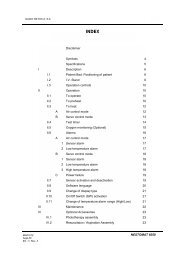GRASEBY 3400 Infusion Pump Operaters Manual - internetMED
GRASEBY 3400 Infusion Pump Operaters Manual - internetMED
GRASEBY 3400 Infusion Pump Operaters Manual - internetMED
You also want an ePaper? Increase the reach of your titles
YUMPU automatically turns print PDFs into web optimized ePapers that Google loves.
Graseby Instruction <strong>Manual</strong>s<br />
This publication has been compiled and approved by Graseby<br />
Medical Ltd for use with their respective products. It is supplied<br />
in this format to permit users to access the text and illustrations<br />
for their own use e.g. training and educational purposes.<br />
Users of the equipment must ensure that they have read and<br />
understood the contents of the complete manual including the<br />
warnings and cautions and have been trained in the correct use<br />
of the product.<br />
Graseby Medical Ltd cannot be held responsible for the<br />
accuracy and any resulting incident arising from information<br />
that has been extracted from this manual and compiled into the<br />
users documentation.<br />
These manuals are subject to revision and it is the users<br />
responsibility to ensure that the correct version of manual/<br />
text/illustration is used in conjunction with the equipment.
Graseby <strong>3400</strong><br />
Syringe <strong>Pump</strong><br />
Instruction <strong>Manual</strong>
Published by Graseby Medical Limited.<br />
All possible care has been taken in the preparation of this publication, but Graseby Medical<br />
Limited accepts no liability for any inaccuracies that may be found.<br />
Graseby Medical reserves the right to make changes without notice both to this publication and<br />
to the product which it describes.<br />
Graseby Medical seek to constantly improve their products, therefore, the specification<br />
of the <strong>3400</strong> pump is subject to change.<br />
Copyright © 2002 Graseby Medical Limited.<br />
No part of this publication may be reproduced, transmitted, transcribed, or stored in a retrieval<br />
system or translated into any human or computer language in any form or by any means without<br />
the prior permission of Graseby Medical Limited.<br />
<strong>GRASEBY</strong> MEDICAL LIMITED,<br />
Colonial Way,<br />
Watford,<br />
Hertfordshire,<br />
United Kingdom,<br />
WD24 4LG<br />
TELEPHONE: (+44) (0)1923 246434<br />
FAX: (+44) (0)1923 231595<br />
www.graseby.co.uk<br />
REGISTERED IN ENGLAND.<br />
COMPANY No. 995550<br />
Trademarks and acknowledgements:<br />
“Graseby”; “Smiths”; and “Flo-Safer” are all trademarks of Smiths Group plc.<br />
All other trademarks are acknowledged as the property of their respective owners.
Aneasthesia syringe pump<br />
Warnings<br />
Warnings tell you about dangerous conditions that could lead to death or serious injury to<br />
the user or patient that can occur if you do not obey all of the instructions in this manual.<br />
1. WARNING: To avoid over- or under- infusion, always verify that the brand and size of the<br />
loaded syringe are the same as the brand and size displayed on the screen before starting<br />
an infusion. Failure to do so may result in an inaccurate delivery of medication, resulting in<br />
patient injury or death.<br />
2. WARNING: To avoid incorrect or inappropriate configuration of the pump, the<br />
Configuration menu must only be selected by qualified persons or authorised personnel.<br />
Incorrect pump configuration could lead to inappropriate infusion resulting in patient<br />
injury or death.<br />
3. WARNING: This equipment is not suitable for use in the presence of flammable<br />
anaesthetics, oxygen-enriched or explosive atmospheres. The use of the device in such<br />
atmospheres may lead to explosion or fire.<br />
4. WARNING: To avoid possible malfunction of the pump, do not expose the pump to X- rays,<br />
gamma rays or ionizing radiation, or to the RF interference or strong electric/magnetic<br />
fields emitted (for example) by diathermy equipment or mobile telephones. If the pump is<br />
used in the presence of, or in combination with Magnetic Resonance Imaging (MRI)<br />
machines it must be protected from the magnetic field emitted by such equipment.<br />
Malfunction of the pump can cause incorrect infusion or loss of infusion resulting in<br />
patient injury or death.<br />
5. WARNING: Operation of the pump outside the temperature limits defined in the<br />
specification may result in erroneous operation. Ensure that the temperature is within the<br />
specified limits. Failure to do so may result in patient injury or user injury.<br />
6. WARNING: In order to ensure that the intended infusion is performed, data must be<br />
entered correctly. Likewise before confirming any displayed data the user should ensure<br />
that it is correct. Failure to do so may result in compromised function of the product,<br />
patient injury or user injury.<br />
7. WARNING: Failure to respond promptly to an alarm may result in patient injury or death.<br />
8. WARNING: Failure to follow the Service <strong>Manual</strong>’s maintenance schedule recommendations<br />
may result in compromised function of the product and lead to patient injury or death.<br />
9. WARNING: It is essential that clinical staff remain within visual and audible range of the<br />
pump so that critical alarms can be seen or heard and responded to.<br />
10. WARNING: The user should ensure that the performance offered by the pump is fit for the<br />
intended purpose. Failure to do so may result in compromised function of the product,<br />
patient injury or user injury.<br />
11. WARNING: When the pump is carrying out an infusion, to ensure that electrical safety is<br />
maintained only items of equipment that conform to EN60950 are to be connected to the<br />
RS232 connector situated at the base of the pump, otherwise patient safety may be<br />
compromised.<br />
Graseby <strong>3400</strong><br />
i
Aneasthesia syringe pump<br />
12. WARNING: Correct management of battery charging is essential to ensure that the pump<br />
can operate on batteries for the time specified. Failure to do so may lead to impaired<br />
functioning of the pump, resulting in patient injury or death.<br />
13. WARNING: Do not use a faulty pump. If the pump develops a fault then an alarm will sound;<br />
the display will indicate a FAULT condition and the pump will fail to infuse. Incorrect<br />
performance of the pump can cause complications resulting in patient injury or death.<br />
If the pump develops a fault then it must be referred to a suitably qualified engineer or<br />
returned to Graseby Medical in order to have the fault rectified.<br />
14. WARNING: Failure to use the mains lead clamp means that the pump may be accidentally or<br />
erroneously disconnected from the mains. Although there is battery backup in case this<br />
happens, the battery may not be sufficiently charged. Consequently there is a risk of the<br />
pump not functioning, which could lead to patient injury or death.<br />
15. WARNING: If an occlusion alarm occurs, immediately clamp the line to eliminate the<br />
possibility of a bolus being delivered to the patient. Then inspect the fluid pathway for kinks,<br />
clogged catheter, etc. in order to remove the occlusion prior to restarting the infusion. An<br />
unintentional bolus of medication can result in patient injury or death.<br />
16. WARNING: Use only the syringes and administration sets listed in the Specification at the<br />
end of this manual. Failure to do so may result in an inaccurate delivery. Graseby Medical<br />
does not guarantee performance of the pump if syringes other than those listed are used.<br />
Incorrect function or performance of the pump can cause complications resulting in patient<br />
injury or death.<br />
17. WARNING: The volume of fluid contained in the connecting tubing is a residual amount and<br />
will not be infused. Hence this extra volume of fluid must be allowed for when initially filling<br />
the syringe and purging the system. Under-delivery of medication can cause complications<br />
resulting in patient injury or death.<br />
18. WARNING: To avoid patient embolism, ensure that the patient tubing is purged of all air<br />
bubbles before administering any medication. The pump provides a purge facility to assist<br />
with this process. The presence of air within the medication can result in complications<br />
leading to patient injury or death.<br />
19. WARNING: To avoid syphoning of the syringe contents (free flow), ensure that the syringe is<br />
correctly loaded into the pump, that the syringe plunger is properly engaged by the pump’s<br />
actuator and that the pump is placed not more than 80cm above the infusion site.<br />
Syphoning can result in over-infusion leading to patient injury or death.<br />
20. WARNING: To avoid over-infusion, do not purge the infusion line when the administration<br />
set is connected to the patient. Over-infusion of medication can result in patient injury or<br />
death.<br />
21. WARNING: To avoid the pump becoming detached from an IV pole always make sure that<br />
the pump is securely fixed to the pole. Always check the security and stability of the<br />
assembly with the pump mounted.<br />
If no IV pole is used make sure that the pump is completely stable on a horizontal surface.<br />
Failure to observe this warning may cause damage to the <strong>3400</strong> Syringe pump and harm<br />
the operator or the patient. As a result, the operator or patient may suffer direct injury, or<br />
the <strong>3400</strong> Syringe pump may fail to operate correctly, leading to patient injury or death.<br />
ii Graseby <strong>3400</strong>
Aneasthesia syringe pump<br />
22. WARNING: Following a significant liquid spill onto the pump, it should be wiped dry and<br />
inspected by service personnel before being returned to service. Failure to do so may<br />
result in compromised functioning of the pump, leading to patient or user injury or death.<br />
23. WARNING: When using a syringe smaller than 50/60 ml the occlusion pressure will<br />
increase as the diameter of the syringe decreases, i.e. the smaller the syringe the higher<br />
the pressure<br />
Cautions<br />
Cautions tell you about dangerous conditions that can occur and cause damage to the pump<br />
if you do not obey all of the instructions in this manual.<br />
1. CAUTION: Refer all service, repair and calibrations only to qualified technical personnel.<br />
Unauthorised modifications to the pump must not be carried out.<br />
2. CAUTION: When turning the pump on if screens similar to those illustrated are not<br />
displayed, do not use the pump. Send the pump to a suitably qualified engineer or return it<br />
to Graseby Medical in order to have the fault rectified.<br />
3. CAUTION: Do not use cleaning and disinfecting agents other than the approved ones<br />
specified here.<br />
4. CAUTION: The pump must not be immersed in any liquids or exposed to strong organic<br />
solvents. Wipe off spills immediately, and do not allow fluid or residues to remain on the<br />
pump. Additionally, the pump is not designed to be autoclaved, steam-sterilised, ETOsterilised<br />
or subjected to temperatures in excess of 45° C (113° F). Failure to observe this<br />
caution may cause serious damage to the pump.<br />
5. CAUTION: If the pump is used in close proximity to a fluid bag(s), it should where possible,<br />
not be mounted directly underneath the fluid bag(s). This is to minimise the possible risk of<br />
damage to the pump from fluid ingress should the bag rupture or leak during use.<br />
U.S.A. and<br />
Canada<br />
Federal law in the U.S.A. and Canada restricts this device to sale by or on the order of a<br />
licensed Medical Practioner.<br />
Graseby <strong>3400</strong><br />
iii
Aneasthesia syringe pump<br />
iv Graseby <strong>3400</strong>
Anaesthesia Syringe pump<br />
Contents<br />
Page<br />
Introduction........................................................................................ 2<br />
Features .............................................................................................. 3<br />
1. Switching on ............................................................................. 4<br />
2. Loading the syringe.................................................................. 5<br />
3. Setting the infusion rate........................................................... 7<br />
4. Giving a bolus infusion ............................................................ 9<br />
5. Setting the hands-free bolus preset ........................................ 9<br />
6. Starting the infusion ................................................................. 9<br />
7. Using the totaliser .................................................................. 10<br />
8. Stopping the <strong>Infusion</strong>............................................................. 10<br />
9 Switching off ........................................................................... 10<br />
10. Alarms ..................................................................................... 11<br />
11. Battery operation .................................................................... 19<br />
12. Positioning the pump............................................................. 20<br />
13. Cleaning and maintenance..................................................... 20<br />
14. Standards ................................................................................ 22<br />
15. Specification ........................................................................... 24<br />
Graseby <strong>3400</strong><br />
Page 1
Anaesthesia Syringe pump<br />
Introduction<br />
Thank you for choosing a Graseby <strong>3400</strong> Anaesthesia syringe pump. This Instruction<br />
<strong>Manual</strong> contains important information on operating and looking after your pump. So that<br />
you are completely familiar with all of the pump’s features, please take the time to read<br />
this manual before switching on the pump. It is important that all users of the <strong>3400</strong> have<br />
been trained in how to use the pump.<br />
The pump is a micro-computer controlled device developed by Graseby Medical for the<br />
administration of sterile liquids. This compact, robust pump is designed to sit on a table<br />
top or to be pole mounted.<br />
It can be configured to work with one of a range of brands of syringe, and the the brand<br />
that the pump is presently Configured for is displayed.<br />
The pump caters for syringe sizes of 5, 10, 20, 30, 35, 50 and 60 ml, the size is<br />
automatically sensed and displayed.<br />
The pump can be set to dispense liquids at maintenance rates of 0.1 to 400 ml/hr in steps<br />
of 0.1 ml/hr. The rate is entered via a numeric keypad and can be adjusted whilst the<br />
pump is infusing. Similarly the bolus infusion rate can be adjusted from 0.1 to 1200 ml/hr<br />
in steps of 0.1 ml/hr.<br />
A dose rate calculation is also possible, allowing the infusion rate to be programmed in a<br />
range of units, including ml/hr, mg/kg/hr, mg/kg/min, mg/kg/hr, mg/kg/min, mg/hr and mg/<br />
hr.<br />
A handsfree preset bolus allows a predetermined bolus to be set and delivered, allowing<br />
the user to concentrate on the patient's response to the medication during the bolus<br />
infusion.<br />
The pump keeps a running total of the volume of liquid infused, even when an infusion is<br />
stopped and restarted.<br />
Safety features have been built into the pump and its software. The pump carries out self<br />
testing routines every time it is switched on. Users are warned of such incidents as<br />
occlusion or power failure by both visible and audible alarms.<br />
The pump can be run from AC mains power (recommended) or from internal rechargeable<br />
batteries which give more than ten hours of use. All the controls are clear and easy to<br />
use. The pump incorporates a graphic liquid crystal display that provides the user with a<br />
constant indication of the pump’s operation.<br />
Page 2<br />
Graseby <strong>3400</strong>
Anaesthesia Syringe pump<br />
Features<br />
Designed in consultation with users, the main features of the pump are:<br />
• 0.1 to 1200.0ml/hr infusion rate.<br />
• Dose rate calculator.<br />
• "Hands-Free" bolus/induction preset.<br />
• Accepts 5 to 60ml syringes, from all major brands.<br />
• RS232 Serial link for remote monitoring and control of infusion.<br />
• AC mains and battery powered.<br />
• More than 10 hours' battery life.<br />
• Simple menu-driven operation.<br />
• Comprehensive safety self check, with clear alarm messages.<br />
• Drip-proof.<br />
Figure 1 Front view of the pump<br />
Graseby <strong>3400</strong><br />
Page 3
Anaesthesia Syringe pump<br />
1. Switching on Connect to AC power. (For battery operation refer to Section 11). Insert<br />
the AC power lead into the rear of the pump. Secure the mains lead with<br />
the clamp as shown in Figure 2, to prevent it from being accidentally pulled<br />
out of the pump.<br />
Figure 2 Mains Lead Clamp<br />
The AC power indicator lamp will illuminate when connected to AC power.<br />
Press the ON key to switch on the pump. A brief self-test procedure will<br />
then be performed, during which a bleep will be heard. The pump is now in<br />
its ‘set-up’ mode, ready for an infusion rate to be set.<br />
WARNING: Do not use a faulty pump. If the pump develops a fault then an<br />
alarm will sound; the display will indicate a FAULT condition and the pump<br />
will fail to infuse. Incorrect performance of the pump can cause<br />
complications resulting in patient injury or death.<br />
If the pump develops a fault then it must be referred to a suitably qualified<br />
engineer or returned to Graseby Medical in order to have the fault rectified.<br />
WARNING: Failure to use the mains lead clamp means that the pump may be<br />
accidentally or erroneously disconnected from the mains. Although there is<br />
battery backup in case this happens, the battery may not be sufficiently<br />
charged. Consequently there is a risk of the pump not functioning, which<br />
could lead to patient injury or death.<br />
Page 4<br />
Graseby <strong>3400</strong>
Anaesthesia Syringe pump<br />
2. Loading the<br />
syringe<br />
2.1<br />
Syringe brand<br />
When the pump is switched on (Section 1) the display will indicate which<br />
syringe brand the pump is calibrated for. The syringes are disposable and are<br />
for single use only.<br />
Syringe brand<br />
Syringe sizes<br />
BD PLASTIPAK<br />
5ml, 10ml, 20ml, 30/35ml, 50/60ml.<br />
BRAUN OMNIFIX<br />
5ml, 10ml, 20ml, 30/35ml, 50/60ml.<br />
MONOJECT<br />
5ml, 10ml, 20ml, 50/60ml.<br />
TERUMO<br />
5ml, 10ml, 20ml, 30/35ml, 50/60ml.<br />
FRESENIUS INJECTOMAT 50ml only.<br />
BRAUN PERFUSOR<br />
50ml only, conversion kit required.<br />
IMS PUMPJET<br />
30ml only, prefilled.<br />
If a syringe size smaller than 50/60 ml is going to be used for an infusion the<br />
following WARNING must be observed.<br />
WARNING: When using a syringe smaller than 50/60 ml the occlusion pressure<br />
will increase as the diameter of the syringe decreases, i.e. the smaller the<br />
syringe the higher the pressure<br />
2.2<br />
Prime syringe<br />
Fill and prime the syringe and catheter in the normal way, ensuring all the air<br />
is expelled.<br />
WARNING: To avoid patient embolism, ensure that the patient tubing is purged<br />
of all air bubbles before administering any medication. The pump provides a<br />
purge facility to assist with this process. The presence of air within the<br />
medication can result in complications leading to patient injury or death.<br />
WARNING: To avoid over-infusion, do not purge the infusion line when the<br />
administration set is connected to the patient. Over-infusion of medication can<br />
result in patient injury or death.<br />
Graseby <strong>3400</strong><br />
Page 5
Anaesthesia Syringe pump<br />
2.3<br />
Insert syringe<br />
Swing the plunger clamp up and away from the body of the pump, until it clicks<br />
and then slide the plunger clamp fully to the right.<br />
Pull the syringe barrel clamp upwards and insert the primed syringe into the<br />
syringe trough. Ensure at the same time that the ear of the syringe is located in<br />
the groove and pushed fully to the left. Ensure that the syringe size sensor is<br />
resting on the syringe barrel.<br />
WARNING: Use only the syringes and administration sets listed in the<br />
Specification at the end of this manual. Failure to do so may result in an inaccurate<br />
delivery. Graseby Medical does not guarantee performance of the pump if<br />
syringes other than those listed are used. Incorrect function or performance of the<br />
pump can cause complications resulting in patient injury or death.<br />
Lower the barrel clamp onto the syringe. Slide the plunger clamp to the left<br />
until it is touching the syringe plunger. Lower the clamp until it clicks over the<br />
syringe plunger. Ensure the plunger cross piece is correctly placed within the<br />
slot in the clamp.<br />
WARNING: To avoid over- or under- infusion, always verify that the brand and size<br />
of the loaded syringe are the same as the brand and size displayed on the screen<br />
before starting an infusion. Failure to do so may result in an inaccurate delivery of<br />
medication, resulting in patient injury or death.<br />
WARNING: To avoid syphoning of the syringe contents (free flow), ensure that the<br />
syringe is correctly loaded into the pump, that the syringe plunger is properly<br />
engaged by the pump’s actuator and that the pump is placed not more than 80cm<br />
above the infusion site. Syphoning can result in over-infusion leading to patient<br />
injury or death.<br />
Check:<br />
Syringe type and size<br />
corresponds to the type<br />
and size of the syringe<br />
you are using<br />
Barrel<br />
clamp<br />
Check:<br />
Syringe size sensor<br />
is located on top of syringe<br />
Check:<br />
Syringe plunger fits into plunger clamp<br />
groove when clamp is lowered<br />
Check:<br />
Syringe ear is<br />
located in groove<br />
GM0760-A<br />
Figure 3 Inserting the syringe<br />
Page 6<br />
Graseby <strong>3400</strong>
Anaesthesia Syringe pump<br />
3. Setting the<br />
infusion rate<br />
3.1 <strong>Infusion</strong> rate memory<br />
After switch on, the pump will display the infusion rate and units that were<br />
memorised since the last time that the pump was used.<br />
3.2.1 Setting the infusion rate<br />
If the memorised rate is not required it can be altered by pressing the<br />
numeric keys to the right of the display. To facilitate ease of setting up, the<br />
keys are arranged in the same format as an electronic calculator.<br />
The infusion rate can be set to between 0.1 ml/hr and 400.0 ml/hr in steps of<br />
0.1ml/hr. For example, to set an infusion rate of 132.5 ml/hr press<br />
➀<br />
➂ ➁ . ➄<br />
3.2.2 Changing the infusion units<br />
If the mass units (dose rate calculator) has been selected in the configuration<br />
program the UNITS menu bar will be displayed. To change the infusion units<br />
press the UNITS menu key until the desired infusion units are shown on the<br />
screen. The infusion rate can then be entered with the numeric keypad.<br />
Press ENTER to confirm the choice of infusion units. The pump will then ask<br />
for the patient weight and/or drug concentration. The values for the patient<br />
weight and/or drug concentration are entered via the numeric keypad and<br />
confirmed with the ENTER menu key. After entering the drug concentration<br />
the END OF MENU, PRESS START TO RUN screen is shown. If the<br />
ENTER key is pressed the pump will display the infusion rate in mass units.<br />
The ml/hr infusion rate will be shown in brackets. Press the START key to<br />
commence the infusion.<br />
Following the start of an infusion the option to change the units will be<br />
disabled until the pump is turned off. The UNITS key wiII be removed from<br />
the menu bar.<br />
Graseby <strong>3400</strong><br />
Page 7
Anaesthesia Syringe pump<br />
3.3. Adjusting the infusion rate whilst infusing<br />
The infusion rate can be adjusted without stopping the infusion, to allow<br />
titration of the drug dose to its physiological effect on the patient.<br />
Whilst infusing press the CHANGE menu key. The pump will display and<br />
continue to infuse at the set infusion rate. The text message...<br />
"NEW RATE = 0.0ml/hr"<br />
appears below the current infusion rate. If infusion units other than ml/hr<br />
are used the screen will show the infusion units in use at the time of<br />
pressing the CHANGE key eg. mg/kg/hr. Enter the desired new infusion<br />
rate via the numeric keypad. Press START to confirm the new infusion<br />
rate. The pump's infusion rate will now change to the new setting, which<br />
will be shown on the LCD screen.<br />
3.4 Maximum infusion rates for different syringe sizes<br />
The maximum <strong>Infusion</strong> Rates for the syringe sizes are:<br />
S yringe Size (ml) Maximum <strong>Infusion</strong> Rate (ml/hr)<br />
Maintenance<br />
Bolus (and under<br />
computer control)<br />
50/60<br />
30/35<br />
20<br />
10<br />
5<br />
400<br />
400<br />
400<br />
200<br />
100<br />
1200<br />
600<br />
400<br />
200<br />
100<br />
The minimum rate is 0.1 ml/hr.<br />
Note: the pump can have a maximum allowable infusion rate set via the<br />
pump's configuration program. If the maximum allowable rate is exceeded<br />
an alarm message is shown briefly (see section 10; Alarms).<br />
3.5 Start-up time<br />
The time taken for a syringe pump to achieve the set infusion rate is known<br />
as the start-up time.<br />
The start-up time is dependant on the infusion rate and the syringe size, the<br />
higher the infusion rate the faster the start-up time. Smaller syringes give<br />
better results at any given flow rate.<br />
Typical start-up times for the pump using a 50ml syringe are:<br />
3 minutes at 5 ml/hr and 15 minutes at 1 ml/hr.<br />
Page 8<br />
Graseby <strong>3400</strong>
Anaesthesia Syringe pump<br />
4. Giving a<br />
bolus infusion<br />
5. Setting the<br />
hands-free<br />
bolus preset<br />
Press the BOLUS key, the display will show the message "PRESS AGAIN" together<br />
with the bolus infusion rate. If the desired bolus infusion rate is shown press the<br />
BOLUS key immediately and hold it depressed. Whilst running in the bolus mode the<br />
alarm lamp and run lamp will flash. The display will show the BOLUS sign flashing and<br />
the total fluid quantity delivered since the BOLUS button was pressed. This total is<br />
added to the total infused counter. To change the bolus infusion rate press the BOLUS<br />
key, followed by the RATE menu key. The desired bolus rate is then entered via the<br />
numeric keypad. Press the BOLUS key to confirm the new bolus infusion rate.<br />
If the hands-free bolus preset is enabled in the pump's configuration program the<br />
following screen will be shown when the BOLUS key is pressed:<br />
PRESS AGAIN<br />
BOLUS RATE = 1200.0 ml/hr<br />
DOSE RATE<br />
6. Starting the<br />
infusion<br />
The bolus rate is adjusted by pressing the RATE menu key, keying in the desired bolus<br />
rate with the numeric keypad and pressing the ENTER key to confirm your setting.<br />
The hands-free bolus dose is entered by pressing the DOSE menu key, followed by the<br />
desired preset level using the numeric keypad. The bolus p350mmHg, using a BD<br />
50ml syringe.350mmHg, using a BD 50ml syringe.reset is then confirmed by pressing<br />
the ENTER menu key. The pump will then prompt the user to deliver the hands-free<br />
bolus by pressing the BOLUS key again. If the user does not wish to deliver the set<br />
hands-free bolus at this time simply ignore the PRESS AGAIN screen message, which<br />
will disappear after 10 seconds.<br />
Press START to begin the infusion at the set infusion rate. The make and size of the syringe<br />
will be displayed briefly, followed by the infusion rate. Check that the syringe size<br />
corresponds with that on the display.<br />
During the infusion the green start lamp will flash and the "pump running" indicator<br />
arrows on the display will flash. In addition the word INFUSING will flash in the display.<br />
If anything occurs to disrupt the infusion the pump will alarm. See section 10; Alarms.<br />
To change the infusion rate without stopping the infusion see section 3.3; Adjusting the<br />
infusion rate whilst infusing.<br />
WARNING: To avoid over- or under- infusion, always verify that the brand and size of the<br />
loaded syringe are the same as the brand and size displayed on the screen before<br />
starting an infusion. Failure to do so may result in an inaccurate delivery of medication,<br />
resulting in patient injury or death.<br />
Graseby <strong>3400</strong><br />
Page 9
Anaesthesia Syringe pump<br />
7. Using the totalizer<br />
The totalizer shows how much drug has been infused.<br />
The totalizer can be accessed when the pump is running or when the pump<br />
is stopped. Press the TOTAL menu key. For a few seconds the display<br />
will show "TOTAL: XXX.X ML".<br />
If the dose rate calculator is in use the totalizer will display the mass of<br />
drug infused, based on a calculation using the actual volume infused and<br />
the current drug concentration.<br />
It is recommended that the total infused counter is reset when changing<br />
the drug concentration to prevent any possibility of misinterpretation of the<br />
calculated total mass of drug infused.<br />
If you wish to reset the totalizer, press the RESET totalizer menu key<br />
when the total is displayed. It is not possible to reset the totalizer without<br />
first accessing the display totalizer program. The totalizer can only be<br />
reset when the pump is stopped.<br />
8. Stopping the infusion<br />
Press the STOP button to stop the infusion. The yellow stop lamp will<br />
illuminate and the pump running indicators in the display will disappear.<br />
9. Switching off<br />
First stop the infusion (see section 8) and then press the OFF button to<br />
switch the pump off. The AC power indicator lamp will remain illuminated if<br />
the pump is connected to the AC power and the batteries will continue to<br />
be charged.<br />
Disconnect from the AC power supply if the pump is not going to be used<br />
for any length of time; the AC power indicator lamp will then extinguish.<br />
Page 10<br />
Graseby <strong>3400</strong>
Anaesthesia Syringe pump<br />
10. Alarms<br />
Quiet alarm<br />
There are several alarm states, each accompanied by a descriptive<br />
message on the display, an audible alarm and a flashing red alarm light. If<br />
the pump was infusing at the time of the alarm then the pump will have<br />
stopped automatically (except for the on battery, low battery, nearly empty<br />
and AC failure alarm). To silence the alarm press the ALARM button.<br />
The following pages give details of the alarm messages and a brief<br />
explanation of their meaning.<br />
When the START button is pressed and a quiet alarm condition is detected<br />
a double beep is sounded accompanied by an alarm display for two<br />
seconds.<br />
WARNING: Failure to respond promptly to an alarm may result in patient<br />
injury or death.<br />
WARNING: It is essential that clinical staff remain within visual and audible<br />
range of the pump so that critical alarms can be seen or heard and<br />
responded to.<br />
Graseby <strong>3400</strong><br />
Page 11
Anaesthesia Syringe pump<br />
10.1 Syringe plunger clamp disengaged<br />
CLAMP OPEN<br />
ALARM TYPE<br />
CAUSE<br />
ACTION<br />
2 second quiet alarm.<br />
The syringe plunger clamp has not been correctly<br />
located over the syringe plunger.<br />
The clamp is not correctly placed in the slot in the<br />
plunger clamp.<br />
Reposition the clamp on the syringe plunger, ensuring the<br />
plunger cross piece is correctly placed in the slot in the<br />
plunger clamp.<br />
10.2 Syringe invalid<br />
SYRINGE INVALID<br />
ALARM TYPE<br />
CAUSE<br />
ACTION<br />
2 second quiet alarm.<br />
The syringe size sensor does not detect a valid syringe in<br />
the syringe trough. Syringe size is too small (or too large).<br />
Ensure the syringe size is appropriate, i.e. 5ml, 10ml,<br />
20ml, 30/35ml or 50/60ml.<br />
Reposition the syringe barrel on the syringe trough.<br />
Page 12<br />
Graseby <strong>3400</strong>
Anaesthesia Syringe pump<br />
10.3 Rate invalid<br />
RATE INVALID<br />
max rate allowed = xxx.x ml/hr<br />
ALARM TYPE<br />
CAUSE<br />
ACTION<br />
2 second quiet alarm.<br />
The START button has been pressed with the infusion<br />
rate set to 00.0 ml/hr or, ... the START button has been<br />
pressed with too high an infusion rate set for the syringe<br />
size in use (see section 3.4; Maximum infusion rates for<br />
different syringe sizes) or, ... the infusion rate has been<br />
set higher than the maximum rate set in the configuration<br />
mode. The maximum allowable infusion rate for<br />
the syringe size in use will be indicated.<br />
Set the desired infusion rate within the permissible<br />
range then start the infusion as described in section 6.<br />
10.4 Review settings<br />
REVIEW SETTINGS<br />
ALARM TYPE<br />
CAUSE<br />
ACTION<br />
2 second quiet alarm.<br />
The START button has been pressed with mass units<br />
selected (e.g. mg/kg/hr) and without reviewing the<br />
patient weight or drug concentration.<br />
Press the ENTER menu key to confirm the patient<br />
weight and/or drug concentration. When the screen<br />
message "END OF MENU, PRESS START TO RUN"<br />
is displayed the infusion can be commenced as<br />
described in section 6.<br />
Graseby <strong>3400</strong><br />
Page 13
Anaesthesia Syringe pump<br />
10.5 Occlusion<br />
OCCLUSION<br />
ALARM TYPE Pulsing loud alarm (silenceable).<br />
CAUSE There is a pressure buildup on the syringe plunger<br />
clamp, probably because of a blocked infusion line.<br />
The infusion has stopped.<br />
ACTION Silence the alarm.<br />
WARNING: If an occlusion alarm occurs, immediately clamp the line to<br />
eliminate the possibility of a bolus being delivered to the patient. Then inspect<br />
the fluid pathway for kinks, clogged catheter, etc. in order to remove the<br />
occlusion prior to restarting the infusion. An unintentional bolus of medication<br />
can result in patient injury or death.<br />
To remove the pressure, swing the syringe plunger clamp<br />
away from the body of the pump and slide to the right. Then<br />
deal with the occlusion. Reposition the plunger clamp. If the<br />
START key is pressed before the plunger has been opened<br />
the pump will not run and the message RELEASE CLAMP<br />
will be displayed briefly. Restart the infusion as described in<br />
section 6.<br />
10.5.1 Occlusion sensing system<br />
The pump has a sensitive, internal occlusion pressure detector which detects the<br />
pressure build-up on the syringe plunger, an occlusion is usually caused by a<br />
blocked infusion line. The pressure at which the pump's occlusion alarm<br />
activates is adjustable from 1.85 kg to 7.42 kg (250 mmHg to 1000 mmHg). The<br />
factory set occlusion pressure is between 5.7 kg and 6.2 kg (767 and 834 mmHg<br />
respectfully for a perfect BD 60 ml syringe).<br />
10.5.2 Time to alarm following occlusion<br />
The time to alarm following occlusion is due to a number of factors which include<br />
the compliance in the syringe and infusion line and mainly the infusion rate. Under<br />
normal conditions and using a non compliant infusion line (i.e. a thick walled nonflexible<br />
line), the time to alarm following occlusion at 1.0 ml/hr is approximately<br />
27 minutes at an occlusion pressure setting of about 350mmHg, using a BD 50ml<br />
syringe.<br />
Page 14<br />
Graseby <strong>3400</strong>
Anaesthesia Syringe pump<br />
This time can be further reduced by reducing the internal occlusion pressure.<br />
A lower pressure will give a shorter time to alarm but there may be an increase<br />
in false alarms. The maximum time to alarm following occlusion will occur at<br />
the lowest settable infusion rate of 0.1ml/hr. At rates as low as this the time<br />
to alarm is likely to be several hours unless smaller syringe sizes are used.<br />
10.6 The nearly empty alarm system<br />
The pump has a unique intelligent nearly empty alarm system. One of two<br />
messages is displayed:<br />
< 3 mins to END<br />
This alarm only operates at infusion<br />
rates at or below 100 ml/hr.<br />
ALARM TYPE<br />
CAUSE<br />
ACTION<br />
Intermittent quiet alarm.<br />
The syringe is nearly empty, there are less than 3 minutes<br />
before the syringe enters the KVO mode (section 10.7).<br />
The pump is continuing to infuse at the set rate.<br />
This alarm can be silenced. If you wish to continue<br />
infusing fill, prime and reload the next syringe (section<br />
2.2). If not, stop the infusion when the end of infusion<br />
alarm sounds (section 10.7/10.8)<br />
NEARLY EMPTY<br />
This alarm operates at infusion rates<br />
above 100 ml/hr, or when a syringe is<br />
loaded with approximately 2.5 cm or<br />
less syringe plunger travel remaining.<br />
ALARM TYPE<br />
CAUSE:<br />
ACTION<br />
Intermittent quiet alarm.<br />
The syringe is nearly empty. The pump is continuing<br />
to infuse at the set rate.<br />
This alarm can be silenced. If you wish to continue<br />
infusing, fill, prime and reload the next syringe (section<br />
2.2). If not, stop the infusion when the<br />
EMPTY/OCCLUSION alarm sounds (section 10.8)<br />
Graseby <strong>3400</strong><br />
Page 15
Anaesthesia Syringe pump<br />
10.7 <strong>Infusion</strong> ended (KVO mode)<br />
ENDED (KVO = .5)<br />
This alarm only operates at infusion<br />
rates at or below 100 ml/hr and<br />
follows the "
Anaesthesia Syringe pump<br />
10.9 Not infusing<br />
NOT INFUSING<br />
ALARM TYPE<br />
CAUSE<br />
CAUSE<br />
ACTION<br />
Intermittent quiet alarm (silenceable).<br />
The pump has been switched on but the START<br />
button has not been pressed.<br />
The infusion may have been stopped (or completed)<br />
and the user has neglected to press the START button<br />
again (or switch the pump off).<br />
Commence the infusion as described in section 6 or<br />
switch the pump off.<br />
10.10 AC power failure<br />
AC MAINS FAIL<br />
ALARM TYPE<br />
CAUSE<br />
ACTION<br />
Intermittent quiet alarm (silenceable).<br />
The AC power supply has been interrupted during an<br />
infusion. The pump will automatically switch to running<br />
on its internal batteries. A fully charged pump will<br />
operate for more than 10 hours.<br />
This alarm can be silenced and the pump will continue<br />
running on its batteries. Reconnect to the AC power as<br />
soon as possible.<br />
Graseby <strong>3400</strong><br />
Page 17
Anaesthesia Syringe pump<br />
10.11 On battery<br />
ON BATTERY<br />
ALARM TYPE<br />
CAUSE<br />
ACTION<br />
No audible alarm, screen indication only. A 'B' will be<br />
shown within the pump running indicator arrow on the<br />
right of the display.<br />
The pump is operating on its internal batteries.<br />
Reconnect to AC power supply if desired.<br />
10.12 Low battery<br />
LOW BATTERY<br />
ALARM TYPE<br />
CAUSE<br />
ACTION<br />
Intermittent quiet alarm (not silenceable).<br />
The pump is operating on its internal batteries, but it may<br />
not be possible for the infusion to continue much longer.<br />
Reconnect to AC power supply immediately.<br />
10.13 Serial RS232 communications failure<br />
COMMS FAILURE<br />
ALARM TYPE<br />
CAUSE<br />
ACTION<br />
Continuous loud alarm (silenceable).<br />
The RS232 connection has been disrupted.<br />
Check the serial interface lead connections and also check<br />
the PC pump controlling software. If the alarm condition is<br />
still unresolved Contact the software publisher, Graseby<br />
Medical or a qualified technician.<br />
RS232 communications are not available in Australia and some other territories.<br />
Page 18<br />
Graseby <strong>3400</strong>
Anaesthesia Syringe pump<br />
10.14 Fault mode<br />
* FAULT 46 *<br />
ALARM TYPE Continuous loud alarm (not silenceable).<br />
CAUSE<br />
There is a fault with the pump.<br />
WARNING: Do not use a faulty pump. If the pump develops a fault then an alarm<br />
will sound; the display will indicate a FAULT condition and the pump will fail to<br />
infuse. Incorrect performance of the pump can cause complications resulting in<br />
patient injury or death.<br />
If the pump develops a fault then it must be referred to a suitably qualified<br />
engineer or returned to Graseby Medical in order to have the fault rectified.<br />
ACTION<br />
Make a note of the fault code number and switch the pump off.<br />
The Technical Service <strong>Manual</strong> (part number 00SM - 0132) gives<br />
further iinformation on the pump's fault codes.<br />
11. Battery<br />
operation<br />
When the pump is switched on but not connected to the AC power supply it will (if the<br />
batteries are charged) operate as if connected to the AC power, except that:<br />
• the AC power lamp will not be illuminated and the following message will be<br />
displayed during operation...<br />
ON BATTERY<br />
• a ‘B’ will be shown within the pump running indicator arrow on the right of<br />
the display,<br />
• the low battery alarm is operative (section 10.11),<br />
• the batteries will be fully charged if the pump has been connected to mains<br />
power for at least 14 hours. When fully charged the batteries will power the<br />
pump for more than 10 hours.<br />
WARNING: Correct management of battery charging is essential to ensure that the pump<br />
can operate on batteries for the time specified. Failure to do so may lead to impaired<br />
functioning of the pump, resulting in patient injury or death.<br />
Graseby <strong>3400</strong><br />
Page 19
Anaesthesia Syringe pump<br />
12. Positioning<br />
the pump<br />
The pump should be positioned and operated horizontally. It may be placed on<br />
a flat stable surface or mounted on a vertical IV pole or rail using the pole<br />
clamp.<br />
CAUTION: If the pump is used in close proximity to a fluid bag(s), it should where<br />
possible, not be mounted directly underneath the fluid bag(s). This is to minimise<br />
the possible risk of damage to the pump from fluid ingress should the bag<br />
rupture or leak during use.<br />
WARNING: To avoid the pump becoming detached from an IV pole always make<br />
sure that the pump is securely fixed to the pole. Always check the security and<br />
stability of the assembly with the pump mounted.<br />
If no IV pole is used make sure that the pump is completely stable on a horizontal<br />
surface. Failure to observe this warning may cause damage to the <strong>3400</strong> syringe<br />
pump and harm the operator or the patient. As a result, the operator or patient<br />
may suffer direct injury, or the <strong>3400</strong> syringe pump may fail to operate correctly,<br />
leading to patient injury or death.<br />
WARNING: Following a significant liquid spill onto the pump, it should be wiped<br />
dry and inspected by service personnel before being returned to service. Failure<br />
to do so may result in compromised functioning of the pump, leading to patient or<br />
user injury or death.<br />
13. Cleaning and maintenance<br />
Cleaning<br />
The pump may be decontaminated by wiping it with a mild disinfectant solution.<br />
For example, the disinfectant solution may be made by using<br />
sodiudhypochlorite diluted with water, to give a solution of 0.1% available<br />
chlorine. The chlorine concentration will be stated on the product label. The<br />
solution must be freshly made and used within 24 hours of preparation.<br />
WARNING: Following a significant liquid spill onto the pump, it should be wiped<br />
dry and inspected by service personnel before being returned to service. Failure<br />
to do so may result in compromised functioning of the pump, leading to patient or<br />
user injury or death.<br />
CAUTION: Do not use cleaning and disinfecting agents other than the approved<br />
ones specified here.<br />
CAUTION: The pump must not be immersed in any liquids or exposed to strong<br />
organic solvents. Wipe off spills immediately, and do not allow fluid or residues to<br />
remain on the pump. Additionally, the pump is not designed to be autoclaved,<br />
steam-sterilised, ETO-sterilised or subjected to temperatures in excess of 45° C<br />
(113° F). Failure to observe this caution may cause serious damage to the pump.<br />
Page 20<br />
Graseby <strong>3400</strong>
Anaesthesia Syringe pump<br />
Maintenance<br />
The Department of Health, in its publication MDA DB 9503, has<br />
recommended that infusion pumps are checked by a qualified technician at<br />
regular intervals.<br />
Graseby Medical supports this policy and recommends that for all our<br />
products the functional and safety tests listed in the Technical <strong>Manual</strong>s are<br />
carried out annually.<br />
Additionally, with reference to the Department of Health publication<br />
‘SAB(94) 26 July 1994’, we recommend that any of our products that have<br />
been dropped, or subjected to severe fluid spills, should be removed from<br />
use immediately and checked by a qualified technician.<br />
For technical and repair information refer to the Graseby Medical Technical<br />
Service <strong>Manual</strong>, part number 00SM-0132.<br />
For further information contact:<br />
Graseby Medical (Customer Care) or your local distributor.<br />
WARNING: Failure to follow the Service <strong>Manual</strong>’s maintenance schedule<br />
recommendations may result in compromised function of the product and<br />
lead to patient injury or death.<br />
CAUTION: Refer all service, repair and calibrations only to qualified<br />
technical personnel. Unauthorised modifications to the pump must not be<br />
carried out.<br />
Spare parts<br />
A list of Spare parts and accessories is provided in each of the following:<br />
• The Graseby Illustrated Parts Catalogue and Price List, part<br />
number 0199-0702.<br />
• The Technical Service <strong>Manual</strong>, part number 00SM-0132.<br />
Graseby <strong>3400</strong><br />
Page 21
Anaesthesia Syringe pump<br />
14. Standards<br />
Insulation<br />
The pump is a Class II (double insulated) device.<br />
(Also classified as Internally Powered Equipment).<br />
Type CF (Cardiac Floating) insulation on all inputs.<br />
Safety<br />
EN6060-1<br />
EMC<br />
EN6060-1-2<br />
Fluid ingress<br />
IPX1 protection against drops of water falling vertically.<br />
Registered design applied for. UK PATENT NO. 2229497<br />
CE Marking<br />
0473<br />
The CE mark demonstrates that the pump conforms to the requirements in<br />
the European Council Directive 93/42/EEC concerning medical devices.<br />
The number 0473 identifies the Notified Body under which the Quality<br />
Systems operated within Graseby Medical Ltd are assessed.<br />
Refer to the accompanying instructions on how to use the pump.<br />
CLASSIFIED BY Underwriters Laboratories Inc.WITH RESPECT TO<br />
ELECTRIC SHOCK, FIRE AND MECHANICAL HAZARDS ONLY IN<br />
ACCORDANCE WITH UL 2601-1, CAN/CSA C22.2 No.601.1-M90.<br />
The serial RS232 9-pin ‘D’ connector that is situated on the rear of the pump<br />
enables suitable equipment to be connected to the pump for communication<br />
purposes. To maintain patient safety the external equipment must comply<br />
with IEC 601-1UL 2601-1. The communications protocol can be obtained from<br />
Graseby (Customer Care).<br />
Note: RS232 communications are not available in Australia and some<br />
other territories.<br />
Page 22<br />
Graseby <strong>3400</strong>
Anaesthesia Syringe pump<br />
Disposal<br />
When the time comes to dispose of the pump or its accessories do so in the<br />
best way to minimise any negative impact on the environment.<br />
There are three batteries inside the pump that contain harmful lead and sulphuric<br />
acid. First discharge the batteries by operating the pump, then dismantle the<br />
pump and remove all three batteries. Do not open up the batteries as this will<br />
release the acid. Do not incinerate them as they may explode. Separate them<br />
from the everyday waste, as indicated by the graphic symbol on the batteries.<br />
You may be able to use special recycling or disposal schemes. To find out about<br />
these contact your local waste disposal service.<br />
Separate any other parts of the equipment where arrangements can be made for<br />
their recovery, either by recycling or energy recovery. Larger plastic parts are<br />
marked with a material identification code to facilitate recycling.<br />
Important: Existing national or local regulations concerning waste disposal<br />
must take precedence over this advice.<br />
Graseby <strong>3400</strong><br />
Page 23
Anaesthesia Syringe pump<br />
15. Specification<br />
Weight:<br />
Not exceeding 3.5 kg including batteries and pole clamp.<br />
Nominal size:<br />
325 mm x 195 mm x 115 mm (with pole clamp fitted and plunger clamp closed).<br />
Flow rate:<br />
50/60ml Syringe = 0.1 to 1200.0 ml/hr.<br />
30/35ml Syringe = 0.1 to 600.0 ml/hr.<br />
20ml Syringe = 0.1 to 400.0 ml/hr.<br />
10ml Syringe = 0.1 to 200.0 ml/hr.<br />
5ml Syringe = 0.1 to 100.0 ml/hr.<br />
Drive accuracy:<br />
The delivery volume is accurate to within ±2% over a complete syringe length<br />
(excluding the start-up time).<br />
Syringe brands:<br />
BD PLASTIPAK<br />
BRAUN OMNIFIX<br />
SHERWOOD MONOJECT<br />
TERUMO<br />
FRESENIUS INJECTOMAT<br />
BRAUN PERFUSOR<br />
IMS PUMPJET 30<br />
5ml, 10ml, 20ml, 30/35ml, 50/60ml.<br />
5ml, 10ml, 20ml, 30/35ml, 50/60ml.<br />
5ml, 10ml, 20ml, 50/60ml.<br />
5ml, 10ml, 20ml, 30/35ml, 50/60ml.<br />
50ml only.<br />
50ml only, optional, conversion kit required.<br />
30ml only, prefilled.<br />
AC power supply:<br />
100 to 240 V at 50 to 60 Hz, 40 VA.<br />
Battery type:<br />
The pump can be internally powered by 3 sealed lead acid (Cyclon) batteries.<br />
Battery life:<br />
More than 10 hours when fully charged and under normal conditions.<br />
Page 24<br />
Graseby <strong>3400</strong>
Anaesthesia Syringe pump<br />
Temperature range:<br />
Storage conditions:<br />
-40° to +70°C, 30 to 90% Rh, 700 to 1060 hPa.<br />
Operating conditions:<br />
+5° to +40°C, 30 to 75% Rh, 700 to 1060 hPa.<br />
Adjustable occlusion<br />
pressure:<br />
As factory set the pump gives an occlusion alarm if the force on the syringe<br />
plunger is between 5.7 and 6.2 kg. This force can be adjusted (refer to the<br />
Service <strong>Manual</strong>).<br />
Graseby <strong>3400</strong><br />
Page 25
Anaesthesia Syringe pump<br />
Page 26<br />
Graseby <strong>3400</strong>
For further information, please contact your local distributor or<br />
Graseby Medical direct on +44 (0)1923 246434<br />
Graseby Medical Ltd.<br />
Colonial Way, Watford, Herts, UK, WD24 4LG<br />
Telephone: +44 (0)1923 246434, Facsimile: +44 (0)1923 231595<br />
http://www.graseby.co.uk<br />
Part No. 0132-0044-K<br />
August 2002<br />
© 2002 Graseby Medical Ltd Smiths Medical - A part of Smiths Group plc



